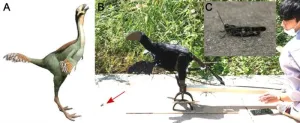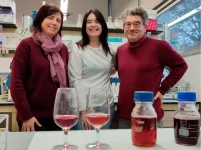(Press-News.org) Philadelphia, January 25, 2024 – The American College of Radiology® (ACR®), working in close collaboration with four other radiology societies from around the world, have issued a joint statement on the development and use of artificial intelligence (AI) tools in radiology. This groundbreaking joint statement is openly available in ACR’s Journal of the American College of Radiology, published by Elsevier. It explores the potential challenges and ethical and safety concerns related to integrating this new technology into radiology practice.
“Developing, Purchasing, Implementing and Monitoring AI Tools in Radiology: Practical Considerations. A Multi-Society Statement from the ACR, CAR, ESR, RANZCR and RSNA” was drafted by representatives of the American College of Radiology, the Canadian Association of Radiologists, the European Society of Radiology, the Royal Australian and New Zealand College of Radiologists, and the Radiological Society of North America.
Bibb Allen, MD, FACR, ACR Data Science Institute Chief Medical Officer, emphasized, “Continuous AI monitoring that captures model performance, examination parameters, and patient demographics in data registries offers significant advantages, including being able to identify the causes of diminished performance in real time and the ability to provide developers with aggregated data for model improvement.”
Christoph Wald, MD, PhD, MBA, FACR, Chair of ACR Commission on Informatics, reiterated, “AI in radiology should ultimately increase patient well-being, minimize harm, respect human rights, and ensure that the benefits and harms are distributed among stakeholders in an equitable way. Since AI heavily relies on data, ethical issues relating to the acquisition, use, storage, and disposal of data are central to patient safety and the appropriate use of AI.”
AI carries the potential for unprecedented disruption in radiology with the possibility of both positive and negative consequences. The integration of AI in radiology could revolutionize healthcare practices by advancing diagnosis, quantification, and management of multiple medical conditions. However, with the expanding availability and capabilities of AI tools in radiology comes an increasing need to critically evaluate claims for AI’s utility and to differentiate safe product offerings from potentially harmful or fundamentally unhelpful ones.
Lead author Prof. Adrian P. Brady, MB BCh, FFRRCSI, FRCR, FRCPC, University College Cork, Ireland, former President and current Chair of the Board of Directors of the European Society of Radiology (ESR) explained, "This paper is critical in ensuring that radiologists can define, enhance, and safeguard the future of medical imaging. As AI becomes increasingly integrated into our field, it brings both tremendous potential and challenges. By addressing practical issues, ethical concerns, and safety considerations, we aim to guide the development and implementation of AI tools in radiology. This paper is not just a statement; it is a commitment to ensuring the responsible and effective use of AI for the betterment of patient care. It sets the stage for a new era in radiology, where innovation is balanced with ethical considerations, and patient outcomes remain our top priority."
Key points emphasize the necessity for increased monitoring of AI utility and safety, advocating for collaboration among developers, clinicians, purchasers, and regulators to navigate ethical concerns and ensure responsible AI integration into radiological practice. In addition, the statement provides valuable insights for stakeholders, offering guidelines on evaluating stability, safety, and autonomous functionality, making it an indispensable resource for the development and implementation of AI in radiology.
The authors stress that AI can fulfill its promise to advance patient well‑being if all steps from development to integration in healthcare are rigorously evaluated. This multi-society statement provides guidance to ensure that the practical issues that surround all stages of AI from conception to long-term integration in healthcare are clear, understood, and addressed, and that patient and societal safety and well-being are the primary drivers of all decisions.
END
American College of Radiology releases joint statement on the use of AI tools in radiology
Leading radiology societies unite to address practical, ethical, and safety considerations surrounding the implementation of AI in medical imaging
2024-01-25
ELSE PRESS RELEASES FROM THIS DATE:
Advancements in IBD care: Natural supplements, disease monitoring via sweat and more
2024-01-25
Las Vegas, NV (Jan. 25, 2024) — The Crohn’s & Colitis Foundation® and the American Gastroenterological Association (AGA) are proud to host the annual Crohn’s & Colitis Congress®, taking place on Jan. 25-27, 2024, in Las Vegas. The Crohn’s & Colitis Congress convenes researchers, clinicians, and other professionals involved in the care of patients with inflammatory bowel disease (IBD) to share the latest research breakthroughs and treatment advancements in IBD. During this premier meeting, we’ll review the latest advancements in IBD care that aim to improve the lives of the millions of Americans living with Crohn’s disease ...
These male marsupials give up sleep for sex
2024-01-25
All animals need sleep. When humans or animals don’t get enough, it can lead to trouble paying attention, irritability, and other ill effects. And yet, researchers reporting in the journal Current Biology on January 25 have made the surprising discovery that a small Australian marsupial called an antechinus will sacrifice hours of sleep per night to make more time for sex during the mating season.
The researchers say the multi-year study is the first to show direct evidence for this type of sleep restriction in any land-dwelling mammal. It’s a trade-off between sleep and reproduction that they say is likely driven by ...
Dinosaurs might have used feathers on forelimbs and tails to flush and pursue their prey – a new hypothesis integrates morphology, behavior and neurobiology
2024-01-25
What are the origins of wings and tails in birds? This is one of the key questions in the evolution of animals. It has long been accepted that their evolution began in feathered dinosaurs. Some of these dinosaurs had feathers on the tails and small wing-like feathers on their forelimbs (arms). These small wing-like structures called ‘proto-wings’ are composed of special feathers known as pennaceous feathers — the stiff feathers found in the wings and tails of birds. The ancient form of these feathers first emerged in dinosaurs during the Jurassic Period, and these dinosaurs, called ...
Palaeontology: Small dinosaurs flapped their feathers to scare prey
2024-01-25
Small omnivorous and insectivorous dinosaurs may have flapped small, feathered primitive wings to scare prey out of hiding places, according to a study published in Scientific Reports. The authors built a robot dinosaur named Robopteryx to investigate how grasshoppers responded to different potential scaring behaviours, and speculate that the results could help explain why feathered wings evolved before they were capable of flight in some types of dinosaurs.
Although the remains of numerous species of feathered dinosaurs have been discovered, so far only members of one group of dinosaurs known as ...
Gaps in the vision screening pathway for school-aged children
2024-01-25
About The Study: The current approach to vision screening in the U.S. may not adequately provide care to all children. At each stage along the care pathway, children from historically marginalized racial and ethnic groups, low-income households, and non–English language speakers experience worse outcomes—they were less likely to receive screening, more likely to be referred for failed screening, and less likely to establish care with a specialist. High referral rates in these vulnerable groups may suggest higher prevalence of undiagnosed conditions or elevated false-positive results from suboptimal screening strategies.
Authors: Isdin Oke, M.D., M.P.H., ...
Suicidal thoughts and trajectories of psychopathological and behavioral symptoms in adolescence
2024-01-25
About The Study: This study of 2,780 adolescents found that persistent withdrawn symptoms and increasing somatic symptoms during early to mid-adolescence were associated with an increased risk of suicidal thoughts in mid-adolescence, even after accounting for comorbid symptoms and confounders. Attention should be paid to the suicidal risk associated with these symptoms, particularly when they persist or increase in the longitudinal follow-up.
Authors: Shuntaro Ando, Ph.D., of the University of Tokyo, is the corresponding author.
To ...
An unconventional yeast increases the quality of carbonic maceration wine, rosé wine and orange wine
2024-01-25
Carbonic maceration wines are increasingly in demand on the market. They are young red wines in which floral and fresh fruit aromas predominate and they must be consumed within the first year. The best-known example is Beaujolais nouveau in France, but there is also a tradition in La Rioja and Catalonia, especially in the Montsant area and the Conca de Barberà.
Research by the URV has found that the quality of these wines can be increased by using an unconventional yeast that considerably improves their organoleptic properties and speeds up the malolactic fermentation process. ...
BU’s Thanh Nguyen, MD, elected President of the Society of Vascular and Interventional Neurology
2024-01-25
FOR IMMEDIATE RELEASE, January 25, 2024
Contact: Gina DiGravio, 617-358-7838, ginad@bu.edu
BU’s Thanh Nguyen, MD, Elected President of the Society of Vascular and Interventional Neurology
First woman to serve as president of the society
(Boston)—Thanh N. Nguyen, MD, FRCP, FSVIN, FAHA, professor of neurology, radiology and neurosurgery at Boston University Chobanian & Avedisian School of Medicine, has been elected President of the Society of Vascular and Interventional Neurology (SVIN), the first woman to serve in this role in its 17-year history.
Previously, Nguyen was an elected board member of SVIN in 2008 and ...
C-Path promotes Cécile Ollivier to Vice President of Global Affairs, expanding leadership in drug development
2024-01-25
AMSTERDAM and TUCSON, Ariz., January 25, 2024 — Critical Path Institute (C-Path) today announced the promotion of Cécile Ollivier, M.S., from Managing Director, Europe to Vice President of Global Affairs.
“We are thrilled to announce the promotion of Cécile Ollivier to Vice President of Global Affairs,” said C-Path Board member Tomas Salmonson Ph.D., M.S. “Cécile has been an invaluable contributor to our European operations, and her extensive experience in global drug development and regulatory science makes her the ideal choice for this expanded role. Her leadership will ...
David Brydges wins 2024 Dannie Heineman Prize for Mathematical Physics
2024-01-25
WASHINGTON, Jan. 25, 2024 – AIP and the American Physical Society (APS) are pleased to announce David Brydges as the recipient of the 2024 Dannie Heineman Prize for Mathematical Physics “for achievements in the fields of constructive quantum field theory and rigorous statistical mechanics, especially the introduction of new techniques including random walk representation in spin systems, the lace expansion, and mathematically rigorous implementations of the renormalization group.”
This annual award recognizes significant contributions within the ...
LAST 30 PRESS RELEASES:
Study showcases resilience and rapid growth of “living rocks”
Naval Research Lab diver earns Office of Naval Research 2025 Sailor of the Year
New Mayo-led study establishes practical definition for rapidly progressive dementia
Fossil fuel industry’s “climate false solutions” reinforce its power and aggravate environmental injustice
Researchers reveal bias in a widely used measure of algorithm performance
Alcohol causes cancer. A study from IOCB Prague confirms damage to DNA and shows how cells defend against it
Hidden viruses in wastewater treatment may shape public health risks, study finds
Unlock the power of nature: how biomass can transform climate mitigation
Biochar reshapes hidden soil microbes that capture carbon dioxide in farmland
Reducing saturated fat intake shows mortality benefit, but only in high-risk individuals
Manta rays create mobile ecosystems, study finds
Study: Mixed results in using lipoic acid to treat progressive multiple sclerosis
Norbert Holtkamp appointed director of Fermi National Accelerator Laboratory
New agentic AI platform accelerates advanced optics design
Biologists discover neurons use physical signals — not electricity — to stabilize communication
Researchers discover that a hormone can access the brain by hitchhiking
University of Oklahoma researcher awarded funding to pursue AI-powered material design
Exploring how the visual system recovers following injury
Support for parents with infants at pediatric check-ups leads to better reading and math skills in elementary school
Kids’ behavioral health is a growing share of family health costs
Day & night: Cancer disrupts the brain’s natural rhythm
COVID-19 vaccination significantly reduces risk to pregnant women and baby
The role of vaccination in maternal and perinatal outcomes associated with COVID-19 in pregnancy
Mayo Clinic smartwatch system helps parents shorten and defuse children's severe tantrums early
Behavioral health spending spikes to 40% of all children’s health expenditures, nearly doubling in a decade
Digital cognitive behavioral treatment for generalized anxiety disorder
Expenditures for pediatric behavioral health care over time and estimated family financial burden
Air conditioning in nursing homes and mortality during extreme heat
The Alps to lose a record number of glaciers in the next decade
What makes a good proton conductor?
[Press-News.org] American College of Radiology releases joint statement on the use of AI tools in radiologyLeading radiology societies unite to address practical, ethical, and safety considerations surrounding the implementation of AI in medical imaging




